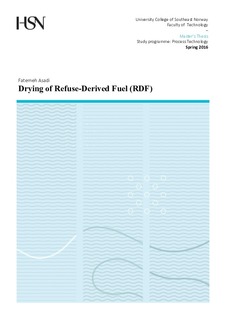| dc.description.abstract | Refuse-Derived fuel (RDF) application in high energy demanding plants as a secondary fuel has risen over the past decades, causing CO2 emission reduction and fuel cost saving. Lowering the moisture content of this solid fuel is essential to improve RDF heating value (LHV) and to avoid more steam generation in the combustor. Therefore, RDF drying is needed. A feasibility study on RDF direct & indirect steam drying vs. conventional air drying systems was conducted in this project by taking a cement plant data as a case study. Indirect steam drying option was eliminated mainly due to poor drying efficiency for heterogeneous and varying characteristic solids like RDF, in practical tests. The system suggested for direct steam drying of RDF showed that almost 70t/h superheated steam has to flow in a drying loop to evaporate almost 3.2t/h of moisture. Release of this amount of moisture resulted in RDF heating value increase by 32%. However, there are some uncertainties regarding the mentioned system due to lack of pilot results for RDF steam drying. Inherent controllability and operability challenges for steam processing set-ups and further equipment cost for superheated steam generation and temperature rise via an air/steam heat exchanger, left air drying option as the best solution for the studied case.
Available dry and almost dust free hot air in the plant could serve as the drying gas in the air dryer. A comparison between belt dryers and rotary drum dryers was done through several received quotations from vendors. Low temperature belt dryer technology outweighed rotary types in terms of capital cost (0.5-1.5 M€ for quoted belt dryers and 2-3 M€ for rotary dryer) and operational cost. In addition the amount of environmental footprint like dust, VOC emissions and exhaust air temperature was less in belt dryers. However, low-temperature fluid-bed dryers were excluded from the comparison list which should be considered as a potential competitor for belt counterparts. | nb_NO |
